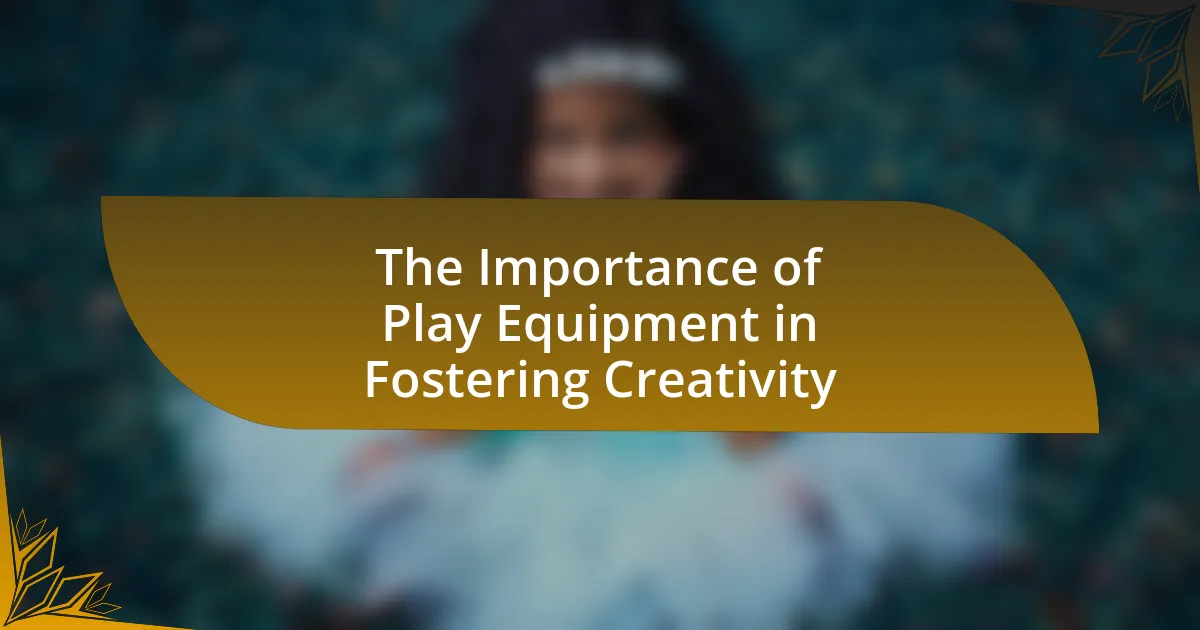Play equipment plays a vital role in fostering creativity among children by providing opportunities for imaginative play and exploration. Engaging with diverse types of play equipment, such as climbing structures and art stations, enhances cognitive flexibility, problem-solving skills, and innovative thinking. Research indicates that open-ended play equipment is particularly effective in promoting creativity, as it allows children to explore various scenarios and express themselves. Additionally, age-appropriate play equipment contributes to the development of physical, cognitive, and social skills tailored to different developmental stages, while also positively impacting emotional well-being and stress relief. The article examines the significance of play equipment in childhood development, highlighting its benefits for creativity, problem-solving, and social interaction.

What is the Importance of Play Equipment in Fostering Creativity?
Play equipment is crucial in fostering creativity as it provides children with opportunities for imaginative play and exploration. Engaging with various types of play equipment, such as climbing structures, art stations, and interactive games, encourages children to think outside the box, solve problems, and express themselves creatively. Research indicates that children who have access to diverse play equipment demonstrate enhanced cognitive flexibility and innovative thinking skills. For instance, a study published in the journal “Child Development” found that children who participated in unstructured play with varied equipment showed greater creativity in tasks requiring original thinking compared to those with limited play options. This evidence underscores the importance of play equipment in nurturing creative development in children.
How does play equipment contribute to creative development?
Play equipment significantly contributes to creative development by providing children with opportunities to explore, experiment, and express themselves through imaginative play. Engaging with various types of play equipment, such as climbing structures, swings, and interactive games, encourages children to think creatively as they navigate challenges, invent scenarios, and collaborate with peers. Research indicates that children who engage in unstructured play with diverse equipment demonstrate enhanced problem-solving skills and greater flexibility in thinking, which are essential components of creativity. For instance, a study published in the journal “Child Development” found that children who frequently use play equipment exhibit higher levels of creative thinking and innovation in their play activities.
What types of play equipment are most effective for fostering creativity?
Open-ended play equipment, such as building blocks, art supplies, and role-playing props, are most effective for fostering creativity. These types of equipment encourage imaginative thinking and problem-solving by allowing children to explore various scenarios and create their own narratives. Research indicates that open-ended materials, like LEGO bricks and craft items, promote divergent thinking, which is essential for creative development. A study published in the journal “Child Development” by researchers at the University of Cambridge found that children who engage with such play equipment demonstrate higher levels of creativity compared to those who use structured toys.
How do different age groups benefit from specific play equipment?
Different age groups benefit from specific play equipment by enhancing their physical, cognitive, and social skills tailored to their developmental stages. For instance, toddlers benefit from soft play structures that promote motor skills and spatial awareness, while preschoolers gain from climbing equipment that fosters risk assessment and problem-solving abilities. School-aged children utilize more complex structures, such as multi-level play systems, which encourage teamwork and strategic thinking. Research indicates that age-appropriate play equipment significantly contributes to developmental milestones; for example, a study published in the “Journal of Play” highlights that children aged 3-5 show improved coordination and social interaction when engaging with interactive play equipment designed for their age group.
Why is creativity essential in childhood development?
Creativity is essential in childhood development because it fosters critical thinking, problem-solving skills, and emotional expression. Engaging in creative activities allows children to explore their imagination, which is crucial for cognitive growth. Research indicates that children who participate in creative play demonstrate improved social skills and adaptability. For instance, a study published in the journal “Child Development” by researchers at the University of California found that creative play enhances children’s ability to collaborate and communicate effectively with peers. This evidence underscores the importance of creativity in shaping well-rounded individuals during formative years.
What role does imaginative play play in creativity?
Imaginative play significantly enhances creativity by allowing individuals to explore scenarios, ideas, and roles beyond their immediate reality. This type of play fosters cognitive flexibility, enabling children to think divergently and generate multiple solutions to problems. Research by Vygotsky emphasizes that imaginative play is crucial for cognitive development, as it encourages symbolic thinking and the ability to envision possibilities. Additionally, a study published in the journal “Creativity Research Journal” found that children engaged in imaginative play demonstrate higher levels of creative thinking and problem-solving skills compared to those who do not participate in such activities.
How does creativity impact problem-solving skills in children?
Creativity enhances problem-solving skills in children by encouraging flexible thinking and innovative approaches to challenges. Engaging in creative activities allows children to explore multiple solutions, fostering cognitive flexibility and resilience. Research by the American Psychological Association indicates that children who participate in creative play demonstrate improved critical thinking and adaptability, essential components of effective problem-solving. This correlation suggests that creativity not only enriches a child’s imaginative capabilities but also equips them with the necessary tools to tackle complex problems effectively.

What are the psychological benefits of play equipment on creativity?
Play equipment significantly enhances creativity by providing a stimulating environment that encourages imaginative play and exploration. Engaging with various types of play equipment allows individuals, particularly children, to experiment with different roles, scenarios, and problem-solving strategies, which fosters divergent thinking. Research indicates that children who regularly interact with play equipment exhibit higher levels of creativity, as they learn to think outside the box and develop innovative solutions to challenges. For instance, a study published in the journal “Child Development” found that children who participated in unstructured play with diverse equipment demonstrated improved creative thinking skills compared to those with limited play options. This evidence supports the notion that play equipment serves as a crucial tool in nurturing creativity through active engagement and exploration.
How does play equipment influence emotional well-being?
Play equipment significantly influences emotional well-being by providing opportunities for physical activity, social interaction, and creative expression. Engaging with play equipment allows children to develop motor skills and build confidence, which contributes to positive self-esteem and emotional resilience. Research indicates that children who regularly use play equipment experience lower levels of anxiety and depression, as play serves as a natural stress reliever. For instance, a study published in the Journal of Play Therapy found that children who participated in play therapy involving various play equipment showed marked improvements in emotional regulation and social skills. This evidence underscores the critical role that play equipment plays in enhancing emotional well-being.
What are the connections between play and stress relief?
Play significantly contributes to stress relief by promoting relaxation and enhancing mood. Engaging in play activates the brain’s reward system, releasing neurotransmitters like dopamine, which are associated with pleasure and stress reduction. Research indicates that play can lower cortisol levels, a hormone linked to stress, thereby fostering a sense of well-being. For instance, a study published in the Journal of Play Therapy found that children who participated in play therapy exhibited reduced anxiety and improved emotional regulation. This evidence underscores the vital role of play in mitigating stress and enhancing overall mental health.
How does play equipment encourage social interaction and collaboration?
Play equipment encourages social interaction and collaboration by providing structured environments where children can engage in group activities. For instance, playgrounds with climbing structures, swings, and slides require children to work together, share space, and negotiate roles during play. Research indicates that children who play together on equipment develop communication skills and learn to resolve conflicts, fostering teamwork. A study published in the Journal of Play in 2015 found that children who engage in cooperative play on shared equipment exhibit increased social skills and empathy, demonstrating the vital role of play equipment in enhancing social dynamics among peers.
What are the cognitive benefits associated with play equipment?
Play equipment enhances cognitive development by promoting problem-solving skills, creativity, and social interaction. Engaging with various types of play equipment encourages children to think critically as they navigate challenges, such as figuring out how to climb or balance. Research indicates that children who regularly use play equipment exhibit improved spatial awareness and cognitive flexibility, which are essential for learning and adapting to new situations. A study published in the Journal of Play and Development found that children who engage in active play demonstrate higher levels of executive function, which includes skills like working memory and cognitive control. These cognitive benefits underscore the importance of play equipment in fostering overall mental development in children.
How does play equipment enhance critical thinking skills?
Play equipment enhances critical thinking skills by providing children with opportunities to engage in problem-solving and decision-making activities. When children interact with various types of play equipment, such as climbing structures or puzzles, they are challenged to think critically about how to navigate obstacles, assess risks, and devise strategies for play. Research indicates that such interactive play fosters cognitive development; for instance, a study published in the journal “Child Development” found that children who engage in unstructured play demonstrate improved problem-solving abilities and creativity. This evidence supports the notion that play equipment serves as a vital tool in developing critical thinking skills through active engagement and exploration.
What is the relationship between play and cognitive flexibility?
Play enhances cognitive flexibility by providing opportunities for children to engage in imaginative scenarios, problem-solving, and adapting to new rules. Research indicates that play, particularly unstructured play, encourages the development of executive functions, which include cognitive flexibility. A study by Ginsburg (2007) in the journal “Pediatrics” highlights that play fosters critical thinking and adaptability, essential components of cognitive flexibility. Engaging in diverse play activities allows children to practice switching between different tasks and perspectives, thereby strengthening their ability to adjust their thinking in response to changing environments.

How can play equipment be effectively integrated into learning environments?
Play equipment can be effectively integrated into learning environments by designing spaces that encourage active engagement and exploration. This integration can be achieved through the incorporation of versatile play structures that promote physical activity, social interaction, and cognitive development. Research indicates that environments combining play and learning enhance creativity; for instance, a study by the University of Illinois found that children exposed to play-based learning showed a 30% increase in problem-solving skills compared to traditional learning methods. By strategically placing play equipment within classrooms and outdoor areas, educators can create dynamic learning experiences that stimulate imagination and foster collaborative skills among students.
What strategies can educators use to incorporate play equipment in classrooms?
Educators can incorporate play equipment in classrooms by integrating it into daily learning activities and creating designated play areas that encourage exploration and creativity. For instance, using building blocks during math lessons can enhance spatial awareness while fostering problem-solving skills. Research indicates that play-based learning significantly improves cognitive development; a study by the American Academy of Pediatrics highlights that children learn best through play, which supports the idea that incorporating play equipment can enhance educational outcomes. Additionally, rotating different types of play equipment, such as art supplies or sensory bins, can keep students engaged and stimulate their creativity, as varied experiences are crucial for developing innovative thinking.
How can play equipment be tailored to different learning styles?
Play equipment can be tailored to different learning styles by incorporating various sensory experiences and interactive elements that cater to visual, auditory, and kinesthetic learners. For instance, visual learners benefit from colorful structures and visual cues, while auditory learners can engage with equipment that produces sounds or music. Kinesthetic learners thrive on physical interaction, so equipment that encourages movement, such as climbing structures or balance beams, is essential. Research indicates that diverse play environments enhance cognitive development by accommodating these varied learning preferences, ultimately fostering creativity and problem-solving skills in children.
What are the best practices for maintaining play equipment in educational settings?
The best practices for maintaining play equipment in educational settings include regular inspections, timely repairs, and proper cleaning. Regular inspections should occur at least monthly to identify wear and tear, ensuring that any damaged components are addressed immediately to prevent accidents. Timely repairs are crucial; for instance, if a swing is found to be loose, it should be fixed within 24 hours to maintain safety standards. Proper cleaning involves removing debris and sanitizing surfaces to promote hygiene, especially in high-use areas. According to the Consumer Product Safety Commission, maintaining play equipment reduces the risk of injuries, highlighting the importance of these practices in fostering a safe and creative environment for children.
What are some common challenges in using play equipment for creativity?
Common challenges in using play equipment for creativity include limited versatility, safety concerns, and lack of engagement. Limited versatility arises when play equipment is designed for specific activities, restricting imaginative use. Safety concerns can inhibit creative exploration, as caregivers may impose restrictions to prevent injuries. Additionally, lack of engagement occurs when the equipment fails to capture children’s interest, leading to underutilization and diminished opportunities for creative expression. These challenges highlight the need for thoughtfully designed play equipment that encourages diverse and safe creative interactions.
How can safety concerns be addressed while promoting creative play?
Safety concerns can be addressed while promoting creative play by implementing age-appropriate play equipment and regular safety inspections. Age-appropriate equipment ensures that children engage in activities suitable for their developmental stage, reducing the risk of injury. Regular safety inspections, as recommended by the American Society for Testing and Materials (ASTM), help identify and mitigate hazards in play environments, ensuring that equipment is well-maintained and safe for use. Additionally, incorporating safety features such as soft landing surfaces and rounded edges can further enhance safety without stifling creativity.
What solutions exist for limited space when incorporating play equipment?
Solutions for limited space when incorporating play equipment include using multi-functional equipment, vertical play structures, and modular designs. Multi-functional equipment, such as climbing walls that double as slides, maximizes utility in confined areas. Vertical play structures utilize height rather than floor space, allowing for climbing and exploration without requiring a large footprint. Modular designs enable customization and scalability, allowing for the addition or removal of components based on available space. These strategies effectively address space constraints while promoting creative play opportunities.
What practical tips can enhance the use of play equipment for fostering creativity?
To enhance the use of play equipment for fostering creativity, incorporate open-ended play scenarios that encourage imaginative thinking. For instance, providing versatile materials like blocks, art supplies, or costumes allows children to create their own narratives and structures, promoting divergent thinking. Research indicates that children engaged in open-ended play demonstrate higher levels of creativity and problem-solving skills, as shown in a study published in the Journal of Play, which found that children who used flexible play equipment exhibited greater imaginative play compared to those with fixed equipment. Additionally, rotating play equipment regularly can stimulate new ideas and interactions, keeping the play environment dynamic and inspiring.
